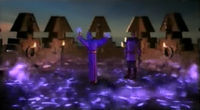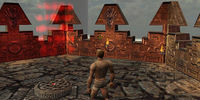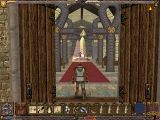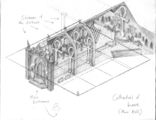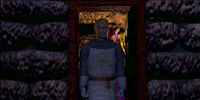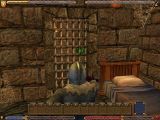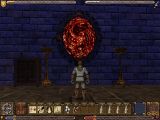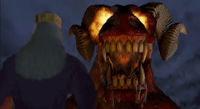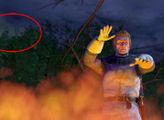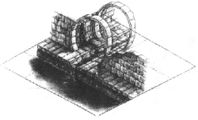Ultima IX plot remnants
Due to the strange development history of Ultima IX, there are numerous remnants of the original plot left in the game, that in of themselves make no sense. It was due to the hasty re-tailoring of the world, that these things either were forgotten, ignored or put into a vastly different context.
Stonegate Roof[edit]
Using the fly-cheat to get to the roof of Stonegate reveals that the roof had been completely constructed, with light sources, a way down, a strange pattern on the ground looking like glyphs, and a teleporter to get into Stonegate itself.
The answer to why such a place exists lies in the original Bob White plot.
Here, the roof of Stonegate was intended for the big finale, where the Avatar and Lord British would cast Armageddon to destroy the Guardian together with Britannia (he had linked himself with Britannia's life force) to end his reign once and for all. The strange glyph pattern on the floor would light up during the casting of the spell, thus why it is on the texture.
Another remnant is, that even in the re-cut Armageddon video of the final game, which is used several times, Stonegate is still seen right at the beginning for a second, pointing to the function of the roof in the original plot.
The video was supposed to show the gypsies of Minoc being annihilated. There are ruins in the background that are found nowhere in Minoc. The answer lies in the fact that originally, this was the end video and showed the ones that had denied coming to Skara Brae and therefore to safety. It could be anywhere on Britannia and was obviously not intended to show Minoc.
The original ending, minus the part where the people on Skara Brae get to safety, is found here.
More Remnants[edit]
There are actually even more remnants that hint at the old plot regarding Stonegate.
The statues of the Shadowlords are there because the Guardian comes from the same source in the original plot, thus also finally explaining why the same set of statues is found in the fortress of the Guardian, much later in the game. With the re-writing of the game, this connection got lost, but the statues remained in the game itself. This connection also explains why Stonegate was built with so much detail, besides the use for the endgame.
Another point are the statues surrounding Stonegate hold pictures of the glyphs, which return to runes on the course of the game. In the final game, the Avatar never has a reason to return to Stonegate, meaning that these statues must have been important in the old plot, where Stonegate played a bigger role and the player would have noticed the changes.
The Cathedral of Love[edit]
The Cathedral of Love in Britain had a more important role in the original plot. It was where the Avatar would meet and re-animate Shamino. Also it was used by Amoranth as his headquarters. Amoranth also had a much bigger role in the original plot as one of the leaders of Britannia and active participant in the war between several factions over the ruling of Britannia.
During the re-design of the plot, practically nothing was left of these plot-points, leading to Amoranth losing his entire plot and background and the cathedral having a more secondary role. However, the cathedral building was not changed in the slightest, resulting in a huge and very detailed building which despite its prominence in Britain has little actual significance in the game itself.
The Prison[edit]
After the Avatar was captured by Blackthorn, the video continues by showing him being thrown into a cell in Deceit. However, the cell in the game looks nothing like the cell in the video – the walls look different, there are no longer bones and the wooden door is suddenly replaced by a metallic grate, not to speak of the bed suddenly found in the cell. Also, the quality of the video seems to degrade a lot between Blackthorn closing Samhayne's door and the Avatar arriving in prison.
Actually, there are two videos – samhayne.dat and prison.dat – the second played immediately after the first. The second video is from the original plot (thus the lower quality since it is older) and in reality shows the Avatar being thrown into dungeon Wrong after being lured into a trap by Blackthorn when trying to expose his dealings. The original version of the video also showed Lord British within the cell, as he was viewing the scene through a message from the Guardian.
The expensive video had to be used so the plot was changed to fit it, but the cell obviously was not changed for it.
Unused Maps[edit]
Shrinking the whole game created lots of maps that no longer had any use in the game. However, they are still in the game, although it takes some effort to reach them. Once found, manifestations reveal some of the cut content.
The topic is so complex, it has it own page: Unused Ultima IX maps.
Mysterious Mirror[edit]
In the game, the Avatar finds a mirror hanging in Lord British's bedroom that looks exactly like the Guardian's Mirror of Darkness. It is rather useless and only shows the Armageddon video, before breaking. Also no one mentions it or why it was there in the first place.
It actually is a remnant from the original plot. In it, the Guardian had somehow made Lord British hanging the mirror into his bedroom and used it together with his own mirror on Terfin to send Lord British nightmares to turn him hostile against the Avatar. These nightmares included the Pyros sequence below, the prison sequence above and several others like seeing the Avatar raise an army to usurp the throne. This is also probably why the Avatar gets karma for destroying it, probably since this would end the nightmares originally.
Of course the karma gain makes no longer any sense, with the nightmare-plot removed.
Pyros[edit]
The sudden plot twist of using Pyros to enter the Abyss seems to be really constructed and also does not even consider Ultima VIII, where Pyros was destroyed by the Avatar.
The answer why this was done lies in the really expensive cut-scene that had been created. Originally it showed a dream of Lord British where the Guardian tells him a lie that the Avatar summons Pyros to destroy Pagan and gets destroyed himself in the end.
In the end they re-cut the video to remove any reference to Lord British and the dream and modeled the area on the Isle of the Avatar to look like the video, just so that they do not have to throw it away. They even obscured the castle in the background with smoke. However, they did not entirely succeed, for a second the wall of Lord British's castle (he sees the whole thing in his dream from the castle balcony) can still be seen in the background.
Hythloth[edit]
In Ultima IX the dungeon Hythloth had been repurposed as the sewer system of old Magincia while in all games before it had been a decaying mine on the Isle of the Avatar. The answer lies in the fact that the dungeon in question actually is not Hythloth. Indeed, it actually is the sewer system of Britain. Since there had been no time to create Hythloth, this hasty solution was found and a room with the column added in so that the glyph-quest could be fulfilled.
This however does have nothing to do with the entrance suddenly being located on New Magincia, or the fact, that Hythloth actually is the dungeon opposing Spirituality, instead of Humility as said in the game.
